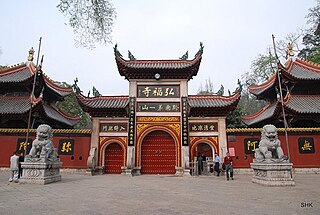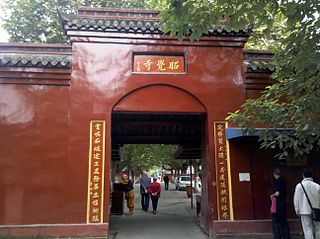Related Research Articles

Tiantong Temple is a Buddhist temple located in Taibai Mountain of Yinzhou District, Ningbo, Zhejiang, in the People's Republic of China. The temple covers a total area of 76,400 square metres (822,000 sq ft), with more than 38,800 square metres (418,000 sq ft) of floor space. Tiantong Temple is listed as one of the "Five Chan Buddhism Temples". Tiantong Temple is the cradle of the Sōtō school of Japanese Buddhism.

The Zhenru Chan Temple is a Chan Buddhist temple located on the southwestern hillside of Mount Yunju in Yongxiu County, Jiangxi, China. Zhenru Chan Temple is the cradle of Caodong school in Chinese Buddhism. The temple has been burned down and rebuilt several times due to wars and fires. The present version was completed in the 1950s.

Kaiyuan Temple is a Buddhist temple located in Xiangqiao District of Chaozhou, Guangdong, China.

Caotang Temple is a Buddhist temple located on the north hillside of Mount Guifeng, in Huyi District of Xi'an, Shaanxi, China.

Zhiyuan Temple is a Buddhist temple located on Mount Jiuhua, in Qingyang County, Anhui, China. Alongside Ganlu Temple, Baisui Palace and Dongyan Chan Temple are honoured as the "Four Buddhist Temple on Mount Jiuhua".

Zhusheng Temple, also known as Boyu'an, is a Buddhist temple located at the foot of Mount Jizu, in Binchuan County, Yunnan.

Hongfu Temple is a Buddhist temple located on Mount Qianling, in Yunyan District of Guiyang, Guizhou, China. Hongfu Temple and Qixia Temple are collectively known as the "Two Attractions in Guiyang".

Baoguo Temple is a Buddhist temple located on Mount Emei, in Emeishan City, Sichuan, China. It is the site of the Buddhist Association of Mount Emei. The temple mainly enshrines Buddhist deities as well as deities of both Confucian and Taoism, which makes rarely seen temple of three religious.

Zhaojue Temple is a Buddhist temple located in Chenghua District of Chengdu, Sichuan, China. Zhaojue Temple has been burned down and rebuilt several times, due to the natural disasters and wars, the modern temple was completed in 1984.

Wuzu Temple is a Buddhist temple located on the Eastern Mountain, in Wuzu Town of Huangmei County, Hubei, China.

Jinshan Temple is a Buddhist temple located in Runzhou District of Zhenjiang, Jiangsu, China.

Yingfeng Temple is a Buddhist temple located in Yingjiang District of Anqing, Anhui, China.

Huayan Temple or Huayan Monastery is a Buddhist temple located in Datong, Shanxi, China.

Huayan Temple is a Buddhist temple located on Mount Zhiti (支提山), in Jiaocheng District of Ningde, Fujian, China. It is the ashram of the Bodhisattva Ratnakūta (天冠菩薩).
Tiantai Temple, also known as the Temple of Ksitigarbha (地藏寺), is the highest Buddhist temple located on Mount Jiuhua, in Qingyang County, Anhui, China. It was first built in the Tang dynasty (618–907), and went through many changes and repairs through the following dynasties. Most of the present structures in the temple were repaired or built in the late Qing dynasty (1644–1911).
Ganlu Temple is a Buddhist temple located on Mount Jiuhua, in Qingyang County, Anhui, China.
Zhantanlin is a Buddhist temple located on Mount Jiuhua, in Qingyang County, Anhui, China.

Jingju Temple is a Buddhist temple located on Mount Qingyuan, in Qingyuan District of Ji'an, Jiangxi, China.
Putong Temple is a Buddhist temple located on Mount Yangqi in Shangli County, Jiangxi, China. It is the cradle of the Yangqi sect of Linji school, one of five schools of Chan Buddhism.
Shangchan Temple is a Buddhist temple located on Mount Jiuhua in Qingyang County, Anhui, China.
References
- ↑ 九华山上的僧侣、游客和居民:咫尺为邻 和而不同(组图)(全文). 163.com (in Chinese). 2015-04-29.
- ↑ 传奇九华山(高清组图). ifeng (in Chinese). 2015-04-24.